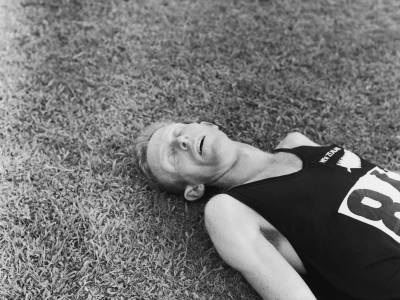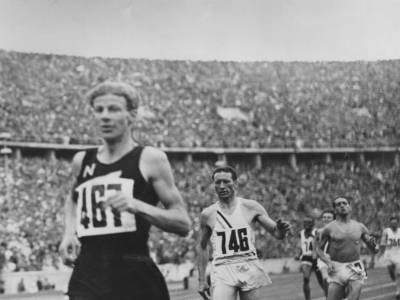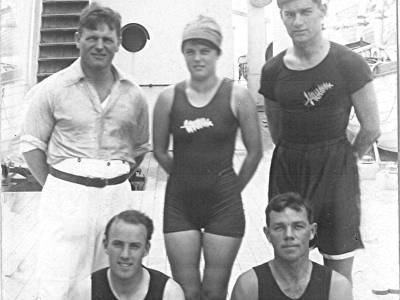Read Episode 1
Read Episode 2
Read Episode 3
Episode Four of our legacy: The Black Singlet - Shaping our Brand
As the black machine cruised up to the start-line of the 1972 Olympic rowing eights final, a shudder ran through the hearts of their rivals.
Simon Dickie, the coxswain of the New Zealand eights, knew his crew looked formidable. Black oars, black boat, black singlet, black shorts. From the moment they lowered the boat off the rack, slipped it into the waters of Oberschleissheim and then executed a long, intense practice start, all eyes were on the New Zealanders.
“The boat was almost hissing, it was so fast,” Dickie recalls. “We were a mean-looking machine. There’s absolutely no question we were intimidating, all in black.”
Dickie was 21, and had already won gold in the coxed four in Mexico, 1968. Four years on in Munich, the men’s eights lined up as favourites to win gold as the reigning world champions, but their path hit rough water when they were surprisingly beaten in the semi-final by West Germany.
Nevertheless, when they lined up for the final, they were confident, and buoyed by the silver medal won by the coxless four earlier that day. The eight flew off the start-line: “After half a dozen strokes we already held a canvas lead,” Dickie says. At the 1000m halfway mark, they had two lengths on the field; with 500m to go, they were still a length ahead. But it wasn’t until the final 200m that Dickie urged them to give all they had left for a final sprint.

“As we closed in on the grandstand, I would be very quiet for two or three strokes, so the guys could hear the chant from the shore ‘Black, black, black’,” says Dickie. “It was so clear that we weren’t doing it for ourselves. We were doing it for our country.”
The New Zealand eight won gold by nearly three seconds from the powerful American and East German crews. It was an unforgettable moment in New Zealand’s sporting history – the first time New Zealand had won gold in rowing’s blue riband event.
New Zealand also brought home a bronze medal from Munich, and 21-year-old Rod Dixon had been preparing for the moment for almost a decade. “I made a black singlet of my own before I was allowed to wear it,” he says.
While at intermediate school in Nelson, Dixon had fashioned himself a black singlet emblazoned with a silver fern. “As a 12-year-old, I imagined I would wear it for New Zealand one day,” he says.
Inspired by the powerful images of his running heroes wearing black – “Lovelock, Halberg, Snell and Magee”- Dixon became a strong middle distance runner. As a teenager, he had posters on his wall of the 1968 Olympic 1500m champion, Kenyan Kip Keino. In 1972, Dixon stood on the dais with Keino, receiving the bronze medal for the 1500m.

After his stunning victory in the 1983 New York marathon, Dixon lined up for the 42.2km distance at the 1984 Los Angeles Olympics. He was given the option of wearing white or black because of the heat: “But I was committed to wearing black.” The heat was never an issue for Dixon, who finished 10th.
Now running his Kids marathon programme in American schools, Dixon gives school coaches black shirts – because he knows the power of black.
***
Trevor Manning was the odd man out in the 1976 New Zealand hockey team – the only man who wore black on the bright green artificial turf of Montreal’s Molson Stadium.
While the rest of his team wore a cooler white, Manning the goalkeeper had a black shirt and white shorts – and a brown cloth golf cap, a pair of gloves and thin bamboo pads. It was a far cry from the full body armour worn by hockey keepers today – and it would provide scant protection for Manning when he was struck by a 100km/h bullet with 10 minutes to go in the ’76 Olympic final.
The Australian shot at goal shattered Manning’s kneecap into pieces, but he continued to make save after save as New Zealand defended a 1-0 lead to win gold against all odds.
Gold medallist Ramesh Patel - the first Indian to play hockey for New Zealand – later became CEO of Hockey New Zealand and helped the national side switch back to black, with white as an alternate strip. “The players preferred wearing black with the silver fern, because it was so much more in line with New Zealand,” he says.
The day after the hockey men won gold, John Walker called on the mana of the black singlet before he ventured out onto the track of the Big O stadium in the heart of Montreal.
In the holding pen before the 1500m final, Walker stripped off his New Zealand tracksuit and strode around, sizing up each of his rivals.
“I walked around in my black singlet and looked at every other runner. I didn’t say a word, but mentally I told them ‘I’m the one you’ve gotta beat’,” he says.
He’s sure they were intimidated before they even got to their marks. In the most mentally demanding race he ever ran, Walker surged into the lead in the final bend and strode out for gold.

*
Legendary New Zealand sailor Ralph Roberts wore black with the silver fern at five different Olympics, in three different roles. He sailed in the Finn dinghy in Rome 1960 and the Flying Dutchman in Mexico 1968, and was reserve to the gold medal-winning crew of Helmer Pederson and Earle Wells in Tokyo 1964.
He was later sailing manager in 1984, where New Zealand yachties won three medals, and then chef de mission of the 1992 New Zealand Olympic team in Barcelona.
Rio 2016 Moscow 1980 Montreal 1976 Munich 1972 Tokyo 1964 Olympic Summer Games John Walker Rod Dixon Jonty Farmer Simon Dickie Trevor Manning Golf Rowing Sailing“Wearing black meant everything,” he says.
“The honour comes in three stages: the first is the anticipation of getting to wear it. The second is the pride in wearing it. And the third, is the execution – proving that you are the best when you are wearing black.”
Tweet Share




